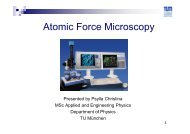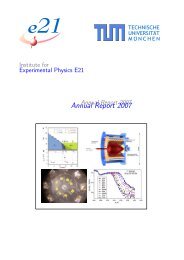Annual Report 2011 / 2012 - E21 - Technische Universität München
Annual Report 2011 / 2012 - E21 - Technische Universität München
Annual Report 2011 / 2012 - E21 - Technische Universität München
You also want an ePaper? Increase the reach of your titles
YUMPU automatically turns print PDFs into web optimized ePapers that Google loves.
Chapter 3. Positron Physics 27<br />
A Precise Measurement of the Decay Rate of the<br />
Negative Positronium Ion Ps −<br />
Hubert Ceeh 1 , Klaus Schreckenbach 1 , Christoph Hugenschmidt 1, 2 , Stefan Gärtner 3 ,<br />
Peter Thirolf 3 , Dirk Schwalm 4<br />
1 Physik Department <strong>E21</strong>, <strong>Technische</strong> Universität München, D-85747 Garching, Germany<br />
2 Forschungsneutronenquelle Heinz Maier-Leibnitz (FRM II), <strong>Technische</strong> Universität München, D-85747 Garching, Germany<br />
3 Ludwig-Maximillians-Universität München, Am Coulombwall 1, D-85748 Garching, Germany<br />
4 Max-Planck-Institut für Kernphysik, Saupfercheckweg 1, D-69117 Heidelberg, Germany<br />
The negative positronium ion Ps − is a bound state consisting<br />
only of three leptons, two electrons and a positron (see<br />
fig. 1). Therefore, Ps − is an ideal object to study the quantum<br />
mechanics of a three-body system. The ground state of<br />
Ps − is stable against dissociation but unstable against annihilation<br />
into photons. A precise measurement of the Ps −<br />
ground state decay rate Γ was carried out at the high intensity<br />
positron source NEPOMUC at the research reactor<br />
FRM II in Garching. A value of Γ = 2.0875(50)ns −1 was<br />
obtained, which is three times more precise compared to<br />
previous experiments and in agreement with most recent<br />
theoretical predictions [1]. The experimental precision that<br />
was achieved is at the level of the leading corrections in the<br />
theoretical predictions.<br />
of the leading order QED corrections (see fig. 2). As these<br />
terms also factor into the ortho- and parapositronium decay<br />
rates, respectively, we may use them to determine the<br />
distinct three body quantity 〈δ +− 〉 from the measured Ps −<br />
decay rate [1]. The cusp 〈δ +− 〉 describes the probability of<br />
finding one of the electrons and the positron at the same<br />
position. This results in<br />
〈δ +− 〉 = 0.020729(50), (1)<br />
and has is to be compared with the theoretical value of<br />
〈δ +− 〉 = 0.020733... assumed to be known up to an accuracy<br />
of 10 −11 [5].<br />
Figure 1: Artistic view of the Ps − ion. The two electrons (green)<br />
are in a singlet state with their spins being aligned anti-parallel,<br />
while the spin orientation of the positron (red) is random. Averaged<br />
distances between the constituents are taken from [2].<br />
Experiment<br />
The method applied already in the previous experiment [3]<br />
was adapted an refined. Details can be found in [4]. Ps − ions<br />
are produced transmitting positrons through a thin diamondlike<br />
carbon foil. The Ps − ions are are accelerated to an<br />
energy of several keV. The number of Ps − ions surviving<br />
the passage through a gap of adjustable width is determined<br />
by stripping the electrons off the ions and detecting the<br />
remaining positrons. The decrease of the number of surviving<br />
Ps − with increasing gap width is directly reflecting the<br />
decay rate Γ Ps −.<br />
Results<br />
The present result is in very good agreement with the most<br />
recent theoretical value of Γ = 2.087963(12)ns −1 [5], which<br />
contains now all correction terms up to order O(α 2 ). Despite<br />
the recent progress in experimental accuracy it is obvious<br />
that due to the recent work of Puchalski et al. theory<br />
is again far ahead of experiment. However, with the experimental<br />
precision we achieved we are now able to probe<br />
theoretical calculations of the decay rate to the precision<br />
Figure 2: Calculated Ps − decay rate with and without QED<br />
corrections according to [5] in comparison to the measured value<br />
from the present work and previous experiments [1, 3, 6].<br />
The precision of the present result allows to experimentally probe<br />
QED correction to the decay rate for the first time.<br />
Outlook<br />
Complementary to the decay rate measurement an experiment<br />
for the Ps − photo detachment and the production of<br />
a mono energetic orthopositronium beam is in preparation<br />
and will soon be operational. It will allow for the measurement<br />
of the photo detachment cross section for different<br />
photon energies in the off-resonant region, as well as the<br />
production of a mono energetic and energy tunable orthopositronium<br />
beam with an intensity of up to a few 10 per<br />
second.<br />
References<br />
[1] Ceeh et al., Phys. Rev: A 84 <strong>2011</strong> 062508 (<strong>2011</strong>)<br />
[2] A. M. Frolov, Phys. Rev. A 60 2834 (1999)<br />
[3] Fleischer et al., Phys. Rev. Lett. 96 063401 (2006)<br />
[4] Ceeh et al., J. Phys.: Conf. Ser. 262 01<strong>2011</strong> (<strong>2011</strong>)<br />
[5] Puchalski et al., Phys. Rev. Lett. 99 203401 (2007)<br />
[6] A. P. Mills, Phys. Rev. Lett. 50 671 (1983)




